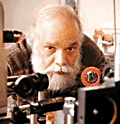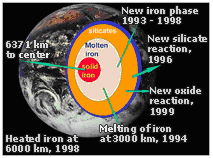X-RAY RUNS: Apply for Beamtime
2017 Nov 1 - Dec 21
2018 Feb 7 - Apr 3
2018 Proposal/BTR deadline: 12/1/17
2018 Apr 11 - Jun 4
2018 Proposal/BTR deadline: 2/1/18

Surendra K. Saxena
Contact: E. Fontes (ef11@cornell.edu)
Surendra K. Saxena, professor of Mechanical and Materials Engineering at Florida International University (FIU) in Miami, was awarded a Rudbeck Medal by Uppsala University in Sweden on January 26th, 2007. The award acknowledges his career of innovative research into high-pressure phenomena and high-pressure materials related to the Earth’s core.
The Rudbeck Medal was first awarded by Uppsala in 2002 on the 300th anniversary of the death of Olof Rudbeck, the elder. Sometimes referred to as “the first Swede to make a scientific discovery,” Rudbeck was a professor of medicine and one of the discoverers of the lymphatic system in humans. He was famous in his day for many remarkable deeds, including raising the roof of the main campus building at Uppsala to create an arena-like “Theatrum anatomicum,” enabling students to learn by viewing actual dissections, and redesigning the layout of the city of Uppsala at the behest of Queen Christina. Rudbeck’s daughter Wendela wed one of her father's former students, Peter Olai Nobelius, grandfather to Alfred Nobel –famous scientist, inventor, and benefactor of the world’s most famous prize.
After accepting the award in Uppsala, Saxena sent an e-mail to his past group members, including over 30 masters students, 15 doctoral students, and 9 post-doctoral fellows: “As I sat on the podium in the University's golden "aula", I was remembering each of you. I would not have deserved the Rudbeck medal without your invaluable work during those ten years. I am very proud of the work we did in Teoretisk geokemi and the international recognition we brought to the university. This all happened mainly due to your innovative pursuits. Please accept my most grateful thanks for fond memories of our time together in Uppsala.”
Educated at the University of Uppsala, Sweden, Surendra K. Saxena held positions there from Research Fellow, to Professor in Theoretical Geochemistry, to department chair. He served on the faculty of the City University of New York and Brooklyn College and in 2001 joined the faculty of FIU. He is currently director of the Center for the Study of Matter at Extreme Conditions Group (CeSMEC) as well as co-director of the FIU Advanced Materials Engineering Research Institute.
Saxena is well known for early theoretical work on thermodynamic calculations and authoring 230 papers and 5 books in the field of Earth and Planetary Science, High-pressure Physics and Materials Science. He is editor of several volumes of Advances in Physical Geochemistry, among others. He is a member of the American Geophysical Union, a Fellow of the American Mineralogical Society, and a member of the Royal Swedish Academy of Science. Two of his books have become standards in the field and are translated into Russian and Chinese: “Thermodynamics of rock-forming crystalline solutions” (Springer-Verlag, New York, 1973) and “Chemical Petrology: with applications to terrestrial planets and meteorites” (with R. F. Mueller, Springer-Verlag, New York, 1977).
His research interests are summarized in the mission statement for CeSMEC; “CeSMEC aims to study the behavior of matter under extreme conditions of pressure and temperature,” and, “The ultimate goal of the materials sciences is to understand the behavior of solids, melts, and fluids over a range of pressures and temperatures well enough to construct detailed, quantitative and predictive models of the physical and chemical processes operating in the industrial systems. Such an inquiry is not limited to materials science alone but is the basis of understanding the nature of materials that exist in space and planetary interiors.”
In 1999 Saxena began the high-pressure program at FIU. At that time, one of his graduate students, Zhongwu Wang, moved from Uppsala to help construct the laboratory in Florida. Wang has since become the high-pressure scientist at the Cornell High Energy Synchrotron Source (CHESS). True to his teacher’s style, Wang continues to support a wide variety of scientific inquiry at two experimental x-ray stations. Members of CeSMEC have been steady CHESS visitors, scheduling over 1550 hours of visits to CHESS since 2001. Over the past two years the group has visited more than 4 separate weeks each year. The group’s projects at CHESS include: high pressure study of nanomaterials (carbides and nitrides), PVT data on iron at the physical conditions of the core, high pressure investigation of post-spinel phase and its implication for superhard materials, phase transitions in MAX-phases and electronic oxides, and high pressure analysis of ternary carbides.
_______________________________________________

Important Results in Planetary
Materials
(from CeSMEC website)
1993: A new phase of iron discovered at 40,000 bar and 2000 K (Saxena et al., 1993) with important consequences for Earth's core.
1994: Iron melting temperature determined to 1.5 million bar (Saxena et al., 1994) with important implications for estimating the temperature of Earth's core.
1996: a) A phase perovskite, considered for decades to be the stable
constituent of Earth's lower mantle, determined to dissociate into
oxides (Saxena et al., 1996). The result affects dynamic modeling of
the planet.
b) In-situ x-ray structure determination of the new iron phase.
1997: a) Experimentally discovered and theoretically confirmed a new phase
of SiO2 at pressures > 500,000 bars (Dubrovinsky et al., 1997).
b) Determination of thermal properties of solids to 3600 K by in-situ x-ray.
1998: a) Physical properties of iron measured to 3.0 million bars and to
1500 K. No laboratory anywhere in the world has succeeded yet in
reaching such extreme conditionsinvolving both pressure and
temperatures (Dubrovinsky et al., 1999).
b) Co6W6C found to be less compressible than diamond.
1999: Dissociation of magnesiowustite at lower mantle conditions which may aid in our study of the dynamics of the mantle.
_______________________________________________
Dubrovinsky, L.S., Saxena, S. K., Lazor, P., Ahuja, R., Eriksson, O., Wills, J.M., and Johansson, B. (1997) Experimental and theoretical identification of a new high-pressure phase of silica. Nature, 388, 362-365.
Saxena, S.K., Dubrovinsky, L.S., Lazor, P., Cerenius, Y., Häggkvist, P., Hanfland, M. and Hu, J. (1996) Stability of perovskite (MgSiO3) in the Earth's mantle. Science, 274, 1357-1359.
Saxena, S.K., Dubrovinsky, L.S., Häggkvist, P., Cerenius, Y., Shen, G. and Mao, H.K., (1995) Synchrotron X-ray study of iron at high pressure and temperature. Science, 269, 1703-1704.
Saxena, S.K., Shen, G. and Lazor, P. (1994) Temperatures in Earth's core based on melting and phase transformation experiments on iron. Science, 264, 405-407.
Saxena, S.K., Shen, G. and Lazor, P. (1993) Experimental evidence for a new iron phase and implications for Earth's core. Science, 260, 1312-1314.
_______________________________________________
Historical source:
"Olaus_Rudbeck." Wikipedia, the free encyclopedia. 16 Feb. 2007 http://www.reference.com/browse/wiki/Olaus_Rudbeck
Florida International University - http://www.eng.fiu.edu/cec/news/CEC_News_Surendra.htm
FIU archived:
(pdf)
